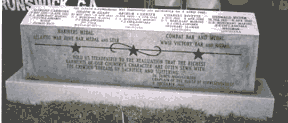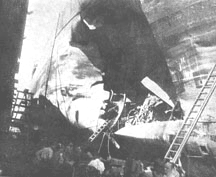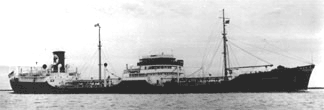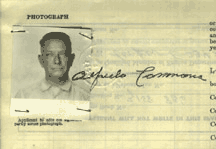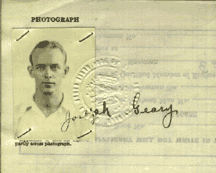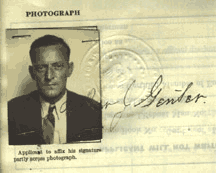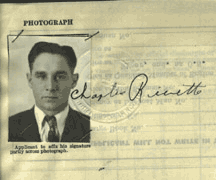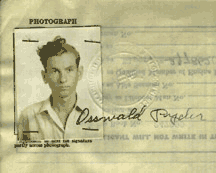http://ajr.org/2014/09/22/bunch-geezers-taught-journalism-used/
http://ajr.org/2014/09/22/bunch-geezers-taught-journalism-used/
What a Bunch of ‘Geezers’ Taught Me About What Journalism Used To Be
Friday, September 26, 2014
Wednesday, September 17, 2014
ernie pyle
The Death of Captain Waskow
|
|
AT THE FRONT LINES IN
ITALY, January 10, 1944 – In this war I have known a lot of officers who were
loved and respected by the soldiers under them. But never have I crossed the
trail of any man as beloved as Capt. Henry T. Waskow of Belton, Texas.
Capt. Waskow was a company
commander in the 36th Division. He had led his company since long before it
left the States. He was very young, only in his middle twenties, but he carried
in him a sincerity and gentleness that made people want to be guided by him.
"After my own father,
he came next," a sergeant told me.
"He always looked
after us," a soldier said. "He’d go to bat for us every time."
"I’ve never knowed
him to do anything unfair," another one said.
I was at the foot of the
mule trail the night they brought Capt. Waskow’s body down. The moon was nearly
full at the time, and you could see far up the trail, and even part way across
the valley below. Soldiers made shadows in the moonlight as they walked.
Dead men had been coming
down the mountain all evening, lashed onto the backs of mules. They came lying
belly-down across the wooden pack-saddles, their heads hanging down on the left
side of the mule, their stiffened legs sticking out awkwardly from the other
side, bobbing up and down as the mule walked.
The Italian mule-skinners
were afraid to walk beside dead men, so Americans had to lead the mules down
that night. Even the Americans were reluctant to unlash and lift off the bodies
at the bottom, so an officer had to do it himself, and ask others to help.
The first one came early
in the morning. They slid him down from the mule and stood him on his feet for
a moment, while they got a new grip. In the half light he might have been
merely a sick man standing there, leaning on the others. Then they laid him on
the ground in the shadow of the low stone wall alongside the road.
I don’t know who that
first one was. You feel small in the presence of dead men, and ashamed at being
alive, and you don’t ask silly questions.
We left him there beside
the road, that first one, and we all went back into the cowshed and sat on
water cans or lay on the straw, waiting for the next batch of mules.
Somebody said the dead
soldier had been dead for four days, and then nobody said anything more about
it. We talked soldier talk for an hour or more. The dead man lay all alone
outside in the shadow of the low stone wall.
Then a soldier came into
the cowshed and said there were some more bodies outside. We went out into the
road. Four mules stood there, in the moonlight, in the road where the trail
came down off the mountain. The soldiers who led them stood there waiting.
"This one is Captain Waskow," one of them said quietly.
Two men unlashed his body
from the mule and lifted it off and laid it in the shadow beside the low stone
wall. Other men took the other bodies off. Finally there were five lying end to
end in a long row, alongside the road. You don’t cover up dead men in the
combat zone. They just lie there in the shadows until somebody else comes after
them.
The unburdened mules moved
off to their olive orchard. The men in the road seemed reluctant to leave. They
stood around, and gradually one by one I could sense them moving close to Capt.
Waskow’s body. Not so much to look, I think, as to say something in finality to
him, and to themselves. I stood close by and I could hear.
One soldier came and
looked down, and he said out loud, "God damn it." That’s all he said,
and then he walked away. Another one came. He said, "God damn it to hell
anyway." He looked down for a few last moments, and then he turned and
left.
Another man came; I think
he was an officer. It was hard to tell officers from men in the half light, for
all were bearded and grimy dirty. The man looked down into the dead captain’s
face, and then he spoke directly to him, as though he were alive. He said:
"I’m sorry, old man."
Then a soldier came and
stood beside the officer, and bent over, and he too spoke to his dead captain,
not in a whisper but awfully tenderly, and he said:
"I sure am sorry,
sir."
Then the first man
squatted down, and he reached down and took the dead hand, and he sat there for
a full five minutes, holding the dead hand in his own and looking intently into
the dead face, and he never uttered a sound all the time he sat there.
And finally he put the
hand down, and then reached up and gently straightened the points of the
captain’s shirt collar, and then he sort of rearranged the tattered edges of
his uniform around the wound. And then he got up and walked away down the road
in the moonlight, all alone.
After that the rest of us
went back into the cowshed, leaving the five dead men lying in a line, end to
end, in the shadow of the low stone wall. We lay down on the straw in the
cowshed, and pretty soon we were all asleep.
Source: Ernie's War: The Best of
Ernie Pyle's World War II Dispatches, edited by David Nichols, pp. 195-97.
Pictures courtesy of The Lilly Library, Indiana University, Bloomington,
Indiana
Tuesday, September 16, 2014
My submarine stories
CLOSE TO HOMEBetween January and May 1942, 82 American vessels hauling badly needed war supplies were sunk by German submarines, often close to the U.S. coast -- including 6 off Georgia and Florida. Killed were hundreds of merchant seamen, civilians who didn't get veteran status until 1988. This is the story of the Georgians who solved the mystery of the SS Oklahoma and its unnamed dead.
by Bill Hendrick
The Atlanta-Journal Constitution, February 14, 1999
[Courtesy of The Atlanta-Journal Constitution http://www.accessatlanta.com/ajc/]
St. Simons Island, Georgia
As never-ending waves splash softly over St. Simons' thin white beach, Don Robertson, 76, zips up his windbreaker, peers toward the dark sea and remembers how it feels to be "out there," on a lightly-armed munitions ship, a floating bomb, knowing that at any second, "you can just go 'poof' --- right up in smoke."
The ex-merchant mariner came awfully close, in the middle of the Atlantic Ocean one night in 1942. His ship, theSS Susana - its holds crammed with explosives - was torpedoed by a German U-boat, and went down "like a funeral pyre," he says. "I was petrified. Just terrified."
He pauses, gesturing toward the horizon: "I guess they were, too."
They were the 38 men of the SS Oklahoma, an oil tanker that was torpedoed by German U-boat 123 just off the coast of this resort island in the wee hours of April 8, 1942. Nineteen merchant mariners were killed.
Four of them, who were burned beyond recognition and buried in Brunswick's Palmetto Cemetery in graves marked "Unknown seamen ---1942," have just been identified. Robertson's chapter of the Propeller Club of the United States has just matched names to the men and is raising funds to honor them with proper gravestones, a monument and a marker in downtown Brunswick honoring all merchant seamen. The club hopes to unveil at least the monument by National Maritime Day on May 22.
"That's something," he marvels to Michael P. Higgins, who spearheaded the club's dogged, yearlong investigation. "Imagine. After all these years. So many died, and [the merchant marine] never got the recognition we deserved."
Higgins has identified the four as Osswald Ryder, 21, of Ville Platte, La.; Joseph Geary, 37, of Boston; Alfredo Carmona, 46, of Puerto Rico; and Arthur Genter, 42, of Evansville, Ind. But he is still far from satisfied. Now Higgins is trying to find any living relatives who "might take comfort in knowing their sons, husbands or brothers" received a decent burial and didn't just vanish into the deep.
Tombstone dedicated Maritime Day, May 22, 1999
Inspired by his father's World War II heroism and newscaster Tom Brokaw's book, "The Greatest Generation," Higgins has become intent on "righting the wrongs" dealt to merchant sailors during the fighting and after."So is Robertson, who was only 19 when his ship went down. "We got shortchanged," he declares, "like some of the Vietnam veterans. Unlike the others, we weren't eligible for veterans' benefits, the GI Bill, even a flag to cover our coffins or a plot in a national cemetery. We weren't seen as real sailors."
Merchant mariners were civilians, employed by companies hired by the government to haul badly needed war supplies: oil, gasoline, guns, food. Those who weren't too old to be drafted, or classified as physically unfit, were exempt from the draft only while sailing.
Though they were relatively few in number, the merchant mariners faced the worst odds, says Higgins --- one out of every 32 who served died, compared with one in every 34 Marines or one in 48 GIs --- and they are considered by many experts to be a prime reason the Allies won the war.
But it wasn't until 1988 that Congress granted the merchant seamen of WWII --- more than 10 percent of whom were African-Americans, serving on integrated crews --- the status of military veterans. And then it applied only to those who sailed between Dec. 7, 1941, and Dec. 15, 1945. Last Veterans Day, President Clinton signed a measure extending the cutoff date to Dec. 31, 1946, the same as that for those in the armed services.
Higgins, an intense, 47-year-old former merchant seaman with two college degrees and his own maritime business, says he was inspired, and a little angered, by all the hoopla last year surrounding the D-Day movie "Saving Private Ryan." The film didn't point out that hundreds of merchant ships were there too, under fire, hauling Allied supplies and men."
We were in Vietnam, Korea, the Persian Gulf, and nobody said anything," Higgins says. "But TV never interviews mariners."
Identifying and honoring the SS Oklahoma's four unknown sailors, says U.S. Rep. Jack Kingston (R-Ga.), who represents coastal Georgia in Congress, is at least a step in the right direction. "Though it's a small gesture in comparison to their sacrifice," he says, "we are hopeful that the loved ones they left behind and the family members they never lived to meet are soon shown this appreciation from a grateful nation."
Torpedo damage to SS Esso Baton Rouge
The SS Oklahoma was one of two merchant vessels that were sunk on the morning of April 8, even though they were hugging the St. Simons coast. The other was the Esso Baton Rouge. Both went down in shallow water, their bows sticking out of the sea. Soon after the blasts that sank them, several Coast Guard vessels and a boat owned by Coca-Cola magnate Charles Candler, steered by his yacht captain, rushed out to rescue any survivors.
The wreck of the SS Oklahoma
They found 19 from the Oklahoma, but couldn't reach that ship's dead. Thirty-eight of the Baton Rouge's 41-man crew took to lifeboats, and its three dead were accounted for. The ships were raised and towed to a spot near the King and Prince Hotel, and the bodies removed, on April 20.
"It was something," says Edwin Fendig, 71, now a harbor pilot and Propeller Club member. "I had a rowboat and took people out to the ships. The holes were gigantic. I went right through."
Adds Jack Lang, 70, a Coca-Cola retiree who was rocked out of bed in nearby Brunswick when the Oklahoma was struck: "It was like a sonic boom. It took several days for the oil to wash ashore, and the whole place was awash in rumors."
The unknowns were buried on April 26 in a funeral service conducted by two clergymen.
SS Oklahoma in pre-war colors with Texas Company insignia
Unmuddying the waters
Actually there were five of them, not four, and this initially muddied the waters for Higgins.
In 1978, Lozamae Dietzler of Eau Claire, Wis., tried to find out what happened to her brother Charles Rivette, who had been classified as missing and presumed dead since 1942. She called the Coast Guard to see if it had ever updated his files. It hadn't. Dietzler gave up until she heard about a man named Terrence Logan, who ran a veterans' program at the University of Minnesota and reportedly could cut through red tape. Logan agreed to help her, says Dietzler, but he ran into "nothing but stone walls."
Finally, Logan thought to call the Glynn County coroner's office, because he knew the ship had been sunk off St. Simons. Someone there vaguely recalled that five unidentified men from the Oklahoma had been buried.
So Logan simply put two and two together: Rivette had been on the ship; he was never seen again after April 8; so he must lie under one of the burial plaques. In 1979, Logan had the American Legion place a marble marker bearing Rivette's name among the five small plaques.
"It was a great relief," says Dietzler, now 78. "It made me feel better to know he'd been buried on land."
But Rivette's marker only made Higgins more determined to find out the names of the other four. His obsessive search was like following a seed trail to nowhere, through a minefield of answering machines with endless options and bureaucrats with no answers.
Finally, Higgins lucked onto Bill Chubb, a retired Coast Guard commander and now an executive of its National Maritime Center, who soon became just as determined to solve the mystery. Three weeks ago, after navigating through a maze of warehouses and old records, Chubb found what he was looking for: enough evidence to identify the unknowns, including Rivette. He came across the ship's roster, the list of survivors and known dead, and separate files on each seaman. The folders contained personal information and photographs --- but no hint that the Coast Guard was ever told that the five had been recovered.
"It suggests that recovering the bodies must have taken a while," Chubb says. "With so many merchant ships being sunk and so many mariners lost, word of the weeks-later recovery of these bodies may simply have been lost in the confusion."
A government cover-up?
Higgins contends that the government was so deeply involved in stemming panic along the coast that it lost sight of the needs of individual families.
The blasts of the St. Simons sinkings rocked islanders and residents of nearby Brunswick, shattering glass, wrote Michael Gannon in "Operation Drumbeat," as far inland as 18 miles. The sinkings not only brought the seemingly distant war close to home; they helped wake up coastal communities, and President Franklin D. Roosevelt, to the immediacy of the German threat during America's darkest days of World War II.
A few months earlier, the U.S. fleet had been decimated at Pearl Harbor. Headlines were telling of Americans fighting against hopeless odds at Corregidor and Bataan. The public wasn't told much about the coastal battle, and the official word, issued daily, was a lie: "Sighted sub, sunk same."
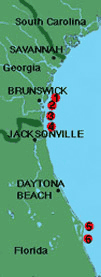 | 1 Oklahoma 4/8/42 2 Esso Baton Rouge 4/8/42 3 Esparta 4/9/42 4 GulfAmerica 4/11/42 5 Leslie 4/13/42 6 Korsholm 4/13/42 |
Actually, few German subs were sighted, and only three were sunk, between January and May 1942, when 82 U.S. merchant vessels went down, often close to America's shoreline. After taking out three merchant vessels off the Georgia coast in the spring of '42, and three off the coast of Florida, the German U-boats moved much farther out to sea.
Higgins is determined to raise America's consciousness about these "unsung heroes."
"Hardly anybody knew so many merchant seamen were dying," he says. "And nobody knew then --- or now --- how close the war came to Georgia. We're trying to change that."
SS Oklahoma Seamen. Can you help find their relatives? e-mail usmm.org @ comcast.net
Alfredo Carmona, 46, (Wiper) He was born in San Juan, PR, he listed a wife in NYC and a friend, Elozia Torres in Tampa, FL. It is possible he has relatives in the coastal southern part (Cape May vicinity) of New Jersey. Joseph Geary, 37, (Cook) of Boston, MA, Father: William Geary, Providence, RI Arthur James Genter, 42, (Oiler) born in New Orleans, LA; Sister: Mrs. M. Meyers lived in Evansville, Indiana. A private detective in New Orleans voluntarily located an 80 year-old niece, Mrs. Frances Hahn living in Evansville, Indiana and his sister in a nursing home in Evansville, Indiana. Charles Rivette, 20, (Ordinary Seaman) Father: Port Arthur, Texas. Family identified. Osswald Ryder, 21, (Messman) Father: John Ryder, Ville Platte, Louisiana.
6/24/99 Sisters and nieces saw story in press and arrived from Louisiana to pay their respects at his grave.Family Visits Grave of Sailor, by Amy Horton The Brunswick News, [Georgia] June 25, 1999
Identification Cards courtesy of Bill Chubb, U.S. Coast Guard
German U-boat commander: Oklahoma was 'a sitting duck'
by Bill Hendrick
The Atlanta-Journal Constitution, February 14, 1999
[Courtesy of: The Atlanta-Journal Constitution]
St. Simons Island, Georgia
The sea was calm, Kapitanleutnant Reinhard Hardegan recalls, when he spotted the SS Oklahoma sailing slowly under a quarter moon within sight of St. Simons' faintly glowing beaches 10 miles away.
"The lights on shore were illuminated," Hardegan said recently from his home in Bremen, Germany. "She was a sitting duck."
Prowling on the surface in the wee hours of April 8, 1942, Hardegan's submarine closed in on the unarmed tanker, laden with 4.4 million gallons of oil. At 500 yards, he gave the order to attack. The torpedo struck the tanker in the engine room, and it quickly sank in water 40 feet deep. Then Hardegan sped away toward the nearby Esso Baton Rouge, sagging with its load of 3.8 million gallons of heating oil, and sank it too.
Nineteen men aboard the Oklahoma were killed; three died on the Esso Baton Rouge.
Sparing civilian lives
It had been a good day for Hardegan, now 85, one of Germany's top submarine aces, who sank 25 ships over the course of the war and, oddly enough, was honored in America many years later. In 1990, for risking his life to avoid killing tourists who had flocked to the beaches on April 11, 1942, the city of Jacksonville welcomed him back as a respected guest.
"There was moonshine, how you say, moonlight," said Hardegan of that night in 1942. "There were lights on the shore. And many people."
Bars were open. People were on the beaches. The U-boat commander could even see a roller coaster, all lit up, and streams of car headlights heading toward the shore.
To avoid hitting civilians with shells --- often used to finish off torpedoed vessels --- Hardegan says, "I went between the coast and the (SS Gulfamerica) so I could shoot in the direction of the sea."
SS Gulfamerica after torpedo attack by Hardegen
It almost cost him his life. An American destroyer soon gave chase and almost got his sub.
"I was received by (the mayor of Jacksonville) in 1990," Hardegan said. "The town was very friendly to me."
More than once, says historian Michael Gannon of the University of Florida, Hardegan gave aid to survivors in lifeboats.
After the war, the ex-sub commander went into the oil business, said Gannon, author of "Operation Drumbeat," which tells the story of the East Coast carnage. He even worked for Texaco, which had owned the SS Oklahoma.
And Hardegan later became friends with Jack Lang, 70, now a Coca-Cola retiree, who was 11 when the Oklahoma was hit. Lang said that the last time he saw Hardegan, the German said, "Enemies yesterday, friends today."
The WWII sinkings set off a wave of hysteria along the East Coast, but it was months before a blackout was imposed. The Coast Guard organized a horse patrol to look for saboteurs who might try to land on the coast. (Some did, but most were quickly caught and executed.) Still, rumors flew that Germans came ashore often to meet spies, buy bread and even attend movies.
"We weren't sent over to see movies, but to sink ships,'' Hardegan laughed. "I read once that a German sub was captured and cinema tickets found. That's nonsense."
Hardegan says he was astonished that it took Washington so long to order the lights off.
"Nearly all the time I saw the coast, the lights were clear. And all the time I was on the surface, the water was so shallow."
Arguing with Hitler
Once, Hardegan got into hot water at home, with none other than Adolf Hitler himself. After receiving the Knight's Cross, the German equivalent of the U.S. Medal of Honor, at a private dinner with the Fuehrer, he questioned the German dictator's tactics.
"I said, 'It would be better to have more air forces and submarines, and fewer tanks,' " Hardegan laughed. "He was angry. He said he knew better. I told him he looked too much to the land, and he didn't like that."
Hardegan was scolded, says Gannon, but replied that it was his duty to offer his opinions.
"I was not a Nazi," Hardegan said. "I did my duty for my country, not for Hitler."
By 1945, the German submarine force was decimated. Of 39,000 men who served, 27,491 were killed and 5,000 captured; of 863 U-boats, 754 were sunk.
Now retired after a successful business career, Hardegan said he's better known in America, thanks to Gannon's book, than in his homeland. But he's still in the sinking business.
"Now I sink putts. Not ships."
[The SS Esso Baton Rouge was salvaged and returned to service. She was torpedoed and sunk on 2/23/43 by U-202, Captain Poser.]
SS Oklahoma
SS Esso Baton Rouge
The Propeller Club, Port of Brunswick, GA, is interested in locating any survivors, or relatives of survivors of U-123's attack on these two vessels during the early morning hours of 8 April 42. We are compiling local residents accounts of this incident as a part of our local history - to be taught in our schools. 5/26/99 Michael Higgins
Further Reading:
Action in the South Atlantic, by Michael Higgins; published by The Propeller Club, Port of Brunswick; P.O. Box 611; Brunswick, GA 31521 on sale for $6.50 plus $3.50 S& H, to raise funds for the two Merchant Marine monuments in Brunswick. Book Review
Ships of the Esso Fleet in World War II, Standard Oil Co. of New Jersey, 1946
Sunday, August 31, 2014
Wednesday, June 25, 2014
Friday, April 4, 2014
An old story I just found. From back in the days when journalism was fun.
CHAOS ON WALL STREET - Gann's Ideas:
Prophecy Or Just Nonsense? - Second of Two Parts
The Atlanta Journal and The Atlanta Constitution - Monday,
September 18, 1989
Readability: >12 grade level (Lexile:
1310L)
Author: HENDRICK, BILL, Bill Hendrick Staff
Writer: STAFF
OVERLAND PARK, Kan. - Bill McLaren once lived in one of the
finest mansions in the Sunflower State. He drove a Rolls-Royce, had a Porsche
911 Targa for sport and dated a Playboy magazine centerfold model.
Then, out of the clear blue Kansas sky, a financial tornado blew
it all away.
The stock market fell apart without warning, and poof - like
magic -everything was gone: the mansion, the cars, the girlfriend. Everything
but the bill collectors. So he hightailed it down to Texas, where he hoped he
could find a place to hide.
Like a lot of people down on their luck, he found God instead.
But more significantly for his bill collectors, he also found a wizard. William
D. Gann.
Like the prophets of old, Gann was long dead. But Mr. McLaren
began studying his teachings, along with the Bible, and concluded that one
reinforced the other. The combination, he says now, 16 years later, changed his
life.
He went to work, paid his bills, returned to Kansas, got married
and had a son, and now lives in a middle-class suburb, coaches Little League
baseball with a passion, drives a BMW, and trades the stock market again for a
living, but much more cautiously.
Though hardly as rich as he once was, he's doing OK, Mr. McLaren
says with a smile, thanks to the teachings of Gann, an obscure, turn-of-the century
stock market prophet who rose from humble beginnings in Lufkin, Texas, to
become one of the biggest tycoons on Wall Street.
Like some modern-day physicists, Gann believed that unseen
"natural forces" had a perceivable impact on the stock market. So does
Mr. McLaren. But he says his years of study of Gann's methods have proven to
him that the market reflects perfect order, rather than the "order in
chaos" some academics claim to be finding.
In short, Gann analysis holds that stocks move according to
strict mathematical rules and that market movements can be predicted with
geometric formulas.
Many market forecasters have equally bizarre beliefs, including
a widely accepted but tamer group of Wall Streeters known as "technical
analysts," who claim history has predictive powers and that mass
psychology rules the market more than economic fundamentals do.
Most academics openly ridicule such notions as mysticism, but
like many other traders with money-making "systems," Mr. McLaren
doesn't care what doubters say and describes his methods with the fire of an
evangelist.
"Look at this," he said excitedly one morning,
unrolling a 4-foot-long chart on his desk. "This is wild."
The chart was covered with squiggly lines as well as straight
ones of various lengths.
"Here's an '82 low," he pointed. "Come up here to
the high. Another 360 degrees gives you this. At this point we're here, within
three points of a full cycle. Here, we've got the one-year cycle coming out.
And this was a key point, because everything vibrated off it."
He jabbed a jagged line with his index finger. "This is
where I got out."
Before the Black Monday crash two years ago, Mr. McLaren said,
he did what his charts and calculator wheels told him to do: He sold his
stocks, and he also sold the market "short." That's a technique in
which traders who want to bet that prices are headed down can borrow stock, on
the hope they can repay the loan with shares purchased at much lower prices.
Phyllis Kahn is perhaps the nation's best-known Gann analyst.
She publishes a popular monthly stock market newsletter called Gann Angles and
claims she also made a fortune during the crash because her charts signaled a
"death zone."
"The market is not chaotic," she said in an interview
in her plush Carmel, Calif. home. "The market is knowable. It's 100
percent knowable. It's totally and completely mathematical."
Like Ms. Kahn, a blond-haired grandmother in her late 50s, and Mr.
McLaren, an intense, chain-smoking, 47-year-old, Gann felt that natural forces
- similar to gravity - affected human behavior on a mass scale and showed up in
the sawtooth patterns of market charts.
He believed the zigs and zags could be predicted precisely with
geometric calculations he devised after years of studying historical prices of
stocks and commodities in moldy archives in New York and London.
Ms. Kahn and Mr. McLaren believe that "price is a function
of time" for individual stocks, commodities and indexes. For example, if
the range between a high and low in the market is 100, then 100 days from the
date of the high, time is said to be "squared," and "when a
square runs out, a change in trend follows," Ms. Kahn said.
The number supposedly works for days, weeks and even years.
"The lowest [point] of the Dow [Jones industrial average]
in this century was 40.5 on July 8, 1932," she explained. According to her
calculations, 40.5 years from July 8, 1932, was Jan. 6, 1973. That was only
five days before the Dow hit what was then an all-time high of 1,067. So within
days of 40.5 years after the Dow bottomed at 40.5, the index peaked. For the
next two years, the market declined, and the Dow ended up at 570. In Gann
analysts' terminology, the market declined after time and price
"squared" with each other. It was during that period that Mr. McLaren
lost his shirt.
Ms. Kahn added, "Every current price swing, major and
minor, is the mathematical result of continuous squaring and re-squaring out of
ranges, highs and lows, from past market movements."
Skeptics assert that Ms. Kahn, Mr. McLaren and, for that matter,
all other ma rket prophets, essentially trick themselves into seeing cycles,
patterns and numerical relationships that really don't exist; they torture data
until it confesses; they see what they want to see.
John D. Palmer, a professor of physiology at the University of
Massachusetts who has long studied human behavior, said people seem to have an
innate desire for orderliness to help them sort out disordered lives, and
they'll grasp at any explanation.
Correlations between various cycles and stock movements that
forecasters see occur "by chance," he said. "They are what we
call nonsense correlations. The stock market moves are just random."
J. Doyne Farmer , a physicist at Los Alamos National
Laboratory who is studying the financial markets to see if any "hidden
order" might exist in data over time, said he also feels that most market
forecasters simply find exactly what they're looking for.
"They sort of sift through the patterns looking for the
right pattern that satisfies their special relationship, and it's always after
the fact: `Ah ha, I've found one that illustrates my theory,' " he said.
But believers like Mr. McLaren couldn't care less about the
skeptics. "I'm making money at it," Mr. McLaren declared.
As strange as such beliefs may seem, Gann's ideas, when compared
to some market theories, sound as conservative as the opinions of a bank
economist. And even in the academic world, seemingly bizarre notions are being
discussed these days.
Physicists like Dr. Farmer in the emerging new field of
"chaos," for example, say they have discovered "hidden
order" in the behavior of many physical systems that previously were
thought to move randomly. And recently, some economists, and a few physicists
like Dr. Farmer, have begun to explore the possibility t hat an abstraction
like the stock market might obey nature's laws of motions that apply to the
physical world.
Though their work is still in the theoretical stages, they hope
to detect patterns in stock movements that could provide clues as to whether
the market might actually be predictable, at least over a very short period of
time.
This new science has resurrected hope on Wall Street that it
might be possible after all to develop new mathematical tools for predicting
the market.
"Wall Street is getting interested," said Peter
Borish, research director for the Tudor Group Inc., one of New York's most
renowned trading firms.
Mr. Borish, a trained economist who said he gets "tons of
phone calls" from self-styled fortune tellers with "magic"
theories, doesn't rule anything out.
"A lot of people thought Einstein was crazy," he said.
"Too many people dismiss ideas just through lack of understanding and
institutional biases."
Mr. McLaren said only a few thousand investors follow Gann's
methods not because they don't work, but because "nobody wants to work
that hard." Gann analysis takes years of study to master, as well as
Prussian-style discipline to do what the angles and other tools dictate, he said.
Mr. McLaren said the tools of Gann's methods warned him the '87
crash was coming and the discipline he'd developed since 1973 helped him ignore
the euphoria that prevailed on Wall Street just before Black Monday.
Mr. McLaren said he advises a few mutual fund managers who
practice Gann analysis but "they have to keep their charts at home or
they'll be discredited" as mystics. Ms. Kahn counts some Wall Street money
managers among her "less than 1,000" subscribers, who pay $360 a year
for her monthly letter.
But such skepticism and name-calling doesn't faze most market
gurus who sell their self-proclaimed expertise, and who, in most cases,
sincerely and ardently believe that they have made earth-rocking discoveries.
"There are many roads that lead to Rome," said Ms.
Kahn.
Caption: Color illustration: Image produced by
a supercomputer showing an ordered pattern within a chaotic event./ Iterated
Systems Inc. Color photo: Bill McLauren./ Cheryl Klauss / Special Color photo:
Mason Sexton is a market forecaster in New York./ Cheryl Klauss / Special
Photo: Phyllis Kahn publishes a popular monthly stock market newsletter, Gann
Angles./ Bill Hendrick / Staff
Edition: The Atlanta Journal Constitution
Section: BUSINESS
Page: D/1
Index Terms: Economics ; Science ; Research
; Forecasts ; Investments ; Series ; Publications
Record Number: 890904217
Copyright 1989 The Atlanta Journal and The Atlanta
Constitution
To bookmark this article, right-click on the link below, and
copy the link location:
Subscribe to:
Posts (Atom)
